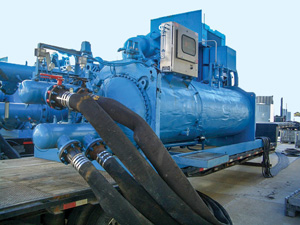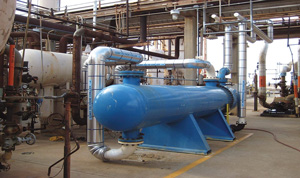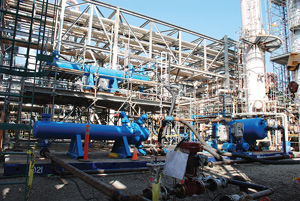Prevent summertime production cutbacks for small-scale LNG
Small-scale natural gas processing facilities are gaining operator interest for their ability to monetize associated gas, although maintaining steady throughput year-round requires planning. Operators without the facilities to handle the associated gas in the production stream may be forced to flare gas, which is wasteful and environmentally undesirable. In areas that ban flaring, operating licenses require the ability to process the associated gas.
An alternative to flaring is to reinject the gas. Reinjection can help maintain reservoir pressure and drive enhanced oil recovery rates, but it can be costly. It is often more profitable to process gas in a way that generates steady revenues and helps governments meet regulatory requirements.
In remote locations, such as North American shale fields, operators can locate small-scale gas plants near gas gathering facilities. Small-scale gas plants must incorporate the basic gas processing steps after the gas leaves the separator system: conditioning the gas by removing acid gases such as hydrogen sulfide (H2S) and carbon dioxide (CO2), generating pipeline-quality natural gas, and fractionating and treating NGL.
Summertime LNG production problems. Examining historical data often yields interesting insights into how well the plant has performed at different times of the year. Throughput is often found to be higher during winter, when ambient air and cooling water temperatures are lower.
High summertime temperatures result in a loss of cooling capacity in crucial process equipment, which leads to reduced throughput or problems with maintaining product purities. This phenomenon is cyclical, as these limits are not evident during winter. Process chilling equipment is particularly susceptible to such limitations.
In general, the temperature of the available cooling medium limits the capacity of a closed-circuit refrigeration machine: Summertime air temperatures can often be 60°F higher than in winter. Similarly, cooling water temperatures can be 30°F–40°F higher during the summer. This discrepancy can have a significant effect on the capacity of the refrigeration system, which, in turn, forces reductions in gas plant throughput. Unfortunately, such production cutbacks—which can be as high as 5%–8%—often coincide with periods when product margins are high.
Fortunately, capacity constraints caused by insufficient cooling can be addressed by deploying supplementary cooling (Fig. 1), which can bring plant throughput and separation efficiencies back to winter-like conditions even during peak summertime temperatures. Timely planning for summertime problems and the deployment of properly designed solutions are essential to mitigating adverse economic impacts caused by throughput reductions.
 |
|
Fig. 1. A large-capacity water-cooled chillera can provide supplemental cooling during summer to help increase processing throughput. |
Addressing cooling constraints. Refrigeration units can be key constraints that limit unit capacity during summer. Supplemental cooling of the condensed refrigerant after the last compression stage can be used to augment refrigeration capacity both effectively and safely.
In general, it is difficult to justify permanent facilities for seasonal needs. Seasonal constraints can be addressed on a temporary basis using rental equipment, which avoids capital expenditures for permanent facilities and is very cost effective. Such supplemental cooling solutions can help improve gas plant and fractionator throughputs by 5%–8% during peak summer months.
Fractionator cooling. Supplemental cooling (Fig. 2) can also bring NGL fractionator capacities back to target capacity during summer. Such limitations are frequently observed with deethanizer, depropanizer and debutanizer columns, all of which require adequate condenser cooling to maintain throughput and product quality.
 |
|
Fig. 2. Cooling with a large heat exchangera helps NGL fractionation plants maximize throughput. |
Supplemental column overhead cooling (Fig. 3) is used to restore fractionation capacity and efficiency. Such capacity improvements can range from 5%–10%.
 |
|
Fig. 3. Supplemental coolinga helps improve unit throughput and maintain product purities to increase NGL recovery. |
Takeaway. Maintaining gas plant and fractionator throughput levels year-round requires planning and careful implementation of properly designed solutions. Engineered temporary supplemental cooling solutions are highly effective in helping maximize profitability and ensure product quality in a consistent and reliable manner. GP
Note
a Equipment shown is supplied by Aggreko.
 |
Umesh Mathur is a Technology Advisor at Aggreko Process Services. He has worked for Aggreko for more than 6 yr. His experience covers 52 yr in process technology, engineering design, plant operations, process control and real-time optimization. He has worked in major refinery, petrochemical, gas processing and fractionation plants in several countries.
 |
Bryan Markland is a Technology Advisor at Aggreko Process Services. He has worked at Aggreko for more than 15 yr. Previously, he worked in refinery operations and process technology at different refineries throughout North America.




Comments